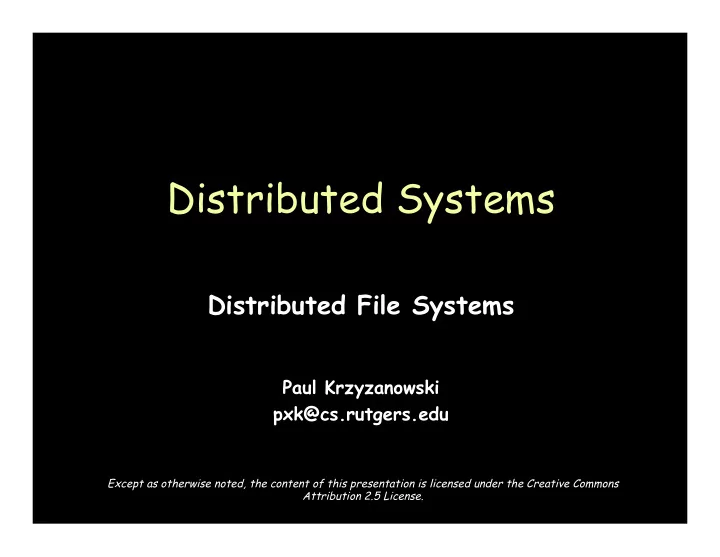

Distributed Systems Distributed File Systems Paul Krzyzanowski pxk@cs.rutgers.edu Except as otherwise noted, the content of this presentation is licensed under the Creative Commons Attribution 2.5 License. Page 1 Page 1
Accessing files FTP, telnet : – Explicit access – User-directed connection to access remote resources We want more transparency – Allow user to access remote resources just as local ones Focus on file system for now NAS: Network Attached Storage Page 2
File service types Upload/Download model – Read file: copy file from server to client – Write file: copy file from client to server Advantage – Simple Problems – Wasteful : what if client needs small piece? – Problematic : what if client doesn’t have enough space? – Consistency : what if others need to modify the same file? Page 3
File service types Remote access model File service provides functional interface: – create, delete, read bytes, write bytes, etc… Advantages: – Client gets only what’s needed – Server can manage coherent view of file system Problem: – Possible server and network congestion • Servers are accessed for duration of file access • Same data may be requested repeatedly Page 4
File server File Directory Service – Maps textual names for file to internal locations that can be used by file service File service – Provides file access interface to clients Client module (driver) – Client side interface for file and directory service – if done right, helps provide access transparency e.g. under vnode layer Page 5
Semantics of file sharing Page 6 Page 6
Sequential semantics Read returns result of last write Easily achieved if – Only one server – Clients do not cache data BUT – Performance problems if no cache • Obsolete data – We can write-through • Must notify clients holding copies • Requires extra state, generates extra traffic Page 7
Session semantics Relax the rules • Changes to an open file are initially visible only to the process (or machine) that modified it. • Last process to modify the file wins. Page 8
Other solutions Make files immutable – Aids in replication – Does not help with detecting modification Or... Use atomic transactions – Each file access is an atomic transaction – If multiple transactions start concurrently • Resulting modification is serial Page 9
File usage patterns • We can’t have the best of all worlds • Where to compromise? – Semantics vs. efficiency – Efficiency = client performance, network traffic, server load • Understand how files are used • 1981 study by Satyanarayanan Page 10
File usage Most files are <10 Kbytes – 2005: average size of 385,341 files on my Mac =197 KB – 2007: average size of 440,519 files on my Mac =451 KB – (files accessed within 30 days: 15, 792 files 80% of files are <47KB) – Feasible to transfer entire files (simpler) – Still have to support long files Most files have short lifetimes – Perhaps keep them local Few files are shared – Overstated problem – Session semantics will cause no problem most of the time Page 11
System design issues Page 12 Page 12
How do you access them? • Access remote files as local files • Remote FS name space should be syntactically consistent with local name space 1. redefine the way all files are named and provide a syntax for specifying remote files • e.g. //server/dir/file • Can cause legacy applications to fail 2. use a file system mounting mechanism • Overlay portions of another FS name space over local name space • This makes the remote name space look like it’s part of the local name space Page 13
Stateful or stateless design? Stateful – Server maintains client-specific state • Shorter requests • Better performance in processing requests • Cache coherence is possible – Server can know who’s accessing what • File locking is possible Page 14
Stateful or stateless design? Stateless – Server maintains no information on client accesses • Each request must identify file and offsets • Server can crash and recover – No state to lose • Client can crash and recover • No open/close needed – They only establish state • No server space used for state – Don’t worry about supporting many clients • Problems if file is deleted on server • File locking not possible Page 15
Caching Hide latency to improve performance for repeated accesses Four places – Server’s disk – Server’s buffer cache WARNING: – Client’s buffer cache cache consistency – Client’s disk problems Page 16
Approaches to caching • Write-through – What if another client reads its own (out-of-date) cached copy? – All accesses will require checking with server – Or … server maintains state and sends invalidations • Delayed writes (write-behind) – Data can be buffered locally (watch out for consistency – others won’t see updates!) – Remote files updated periodically – One bulk wire is more efficient than lots of little writes – Problem: semantics become ambiguous Page 17
Approaches to caching • Read-ahead (prefetch) – Request chunks of data before it is needed. – Minimize wait when it actually is needed. • Write on close – Admit that we have session semantics. • Centralized control – Keep track of who has what open and cached on each node. – Stateful file system with signaling traffic. Page 18
Recommend
More recommend